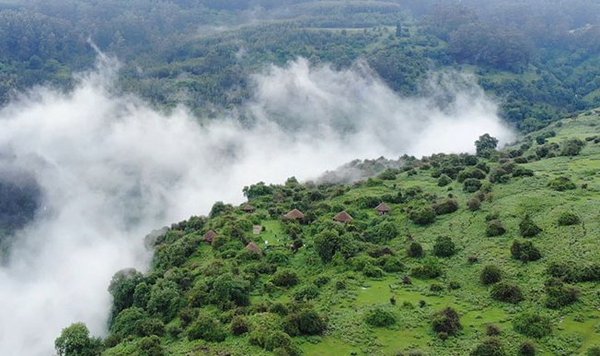 Download this article in magazine layout
Download this article in magazine layout
- Share this article
- Subscribe to our newsletter
From vision to action – towards resilient food systems in Ethiopia’s highlands
Ethiopia largely consists of green and fertile highlands and mountain regions with a moderate to cold climate. From the Northeast to the Southwest, it is traversed by the Great African Rift Valley, with its tropically hot regions. Ethiopia remains one of the world’s least urbanised countries, and has a rural population of more than 80 per cent, consisting predominantly of subsistence farmers. The majority of the population live in small farms without electricity or water supply which are widely scattered across the entire highlands. The people own an average 0.5 hectares of land which is used as an extensive mixed farming system with animal husbandry and crop-growing.
Traditional crop farming comprises tilling by plough and two oxen, manual sowing and harvesting with a scythe by the whole family, drying in the field, thrashing with horses, winnowing and traditional storage in clay vessels or on the clay floor of the huts. In two to three cultivating cycles a year, with only a low level of inputs and usually as rain-fed farming, teff and maize are grown in the lower regions and potatoes, wheat and barley in the highlands. A well-off farmer family owns the livestock needed for crop farming, such as two oxen and horses, as well as some sheep and chickens for subsistence and for livestock breeding. During the day, the farm children tend the livestock, which is free to roam the surroundings and graze, and is fed nothing additionally except leftovers from farming.
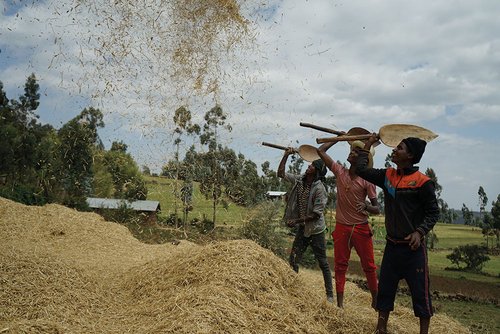
Winnowing with shovels – part of traditional crop farming in the Choke Mountains.
Unsustainable agricultural practices, poor nutrition status
Just like in other countries, the tropical highland regions of Ethiopia are among those areas most threatened by climate change. Nevertheless, just a very small share of them is under conservation. The subsistence farmers depend on the fertile, damp soils of the mountains as their only livelihood source. Along with low productivity in traditional agriculture and a lack of alternative income sources, rapid population growth – it is reckoned that the population will have reached 250 million people by 2050 – has been forcing the local population to clear-cut forests and even grow crops on steep mountain slopes. Erosion, deforestation and loss of biodiversity are the result. Free-range livestock keeping also leads to soil degradation.
In combination with the lack of functioning market structures for farm produce, the traditional production methods result in postharvest losses of up to 50 per cent. Together with climate change, these problems are amplifying pressure on the vulnerable ecosystems. Given the difficult financial situation the smallholders are in, often living on the subsistence minimum, the food situation is also critical. Usually, there are simple dishes without milk or meat products, also thanks to long fasting periods among the Ethiopian Orthodox population. Only little fruit and vegetables are consumed in the highlands, too, which is why, among children in particular, vitamin and nutrient supply is insufficient.
Entry points for sustainable rural development and their investment costs
There are many approaches to a transformation of the production system towards more productivity, resilience and sustainability:
Innovative and sustainable production systems. The permaculture concept, for example, offers a wide range of methods which could be applied on Ethiopian farms. Permaculture is a designing method for the planning of natural habitats and embraces concepts from science, environmental protection, indigenous knowledge and traditional farming practices. For instance, smallholdings can be transformed to a near natural circular economy with vermiculture, apiculture, the integration of fruit trees in farming (following the notion of a Food Forest) and irrigation by swales, which are ditches along the geographical contour lines of slopes facilitating an efficient distribution and storage of rainwater in the fields as well as erosion control. Sustainable pasture management with fenced-in rotating pastures can prevent overgrazing, deforestation and erosion. Such small-scale innovations can be integrated in the existing traditional systems virtually without investment costs.
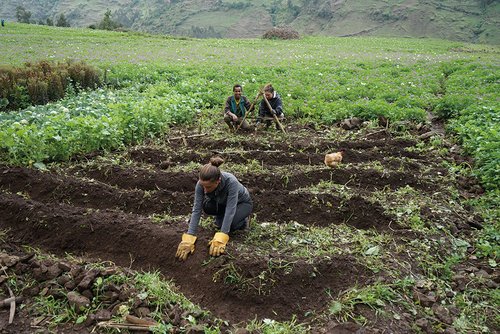
Ditches along the contour lines for efficient irrigation and erosion control.
The integration of renewable energies on farms, such as micro-biogas plants, small, decentralised photovoltaic plants and water systems with solar-powered water pumps, is feasible with only a low level of investments. This enhances farmers’ living standards, creates new opportunities (e.g. through access to the Internet), bridges supply gaps and completes cycles, and protects the environment while remaining sustainable.
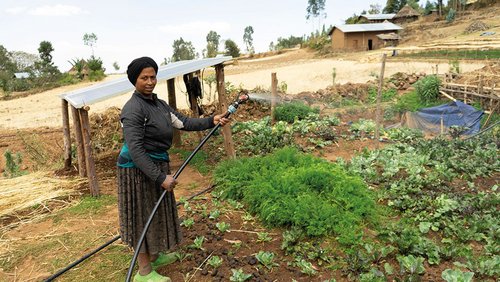
The integration of renewable energies on farms is feasible with only a low level of investments.
As a new type of food in the highlands, fish offers many advantages, especially regarding the provision of nutrients for children. Here, the introduction of innovative technologies such as aquaponics systems in greenhouses would be an option which, however, would require larger, third-party-financed projects. Some of the country’s institutions and NGOs have already engaged in research and breeding focusing on edible fish and aquaponic systems, however only at local level, around the major lakes in lower-lying and warmer regions, in which fish also occur in the natural environment and are therefore already part of the population’s diet.
Despite the good conditions and the potentially large contribution of fish as food, aquaculture has so far not been established on a larger scale in Ethiopia, especially in the highland regions. There, projects and campaigns promoting the introduction of fish to the local diet would have to be run additionally in order to achieve acceptance among the population.
Market-linkage for smallholder farmers. More productive and resilient production systems on small subsistence farms contribute to more diversified and healthier diets, to food security for the country as a whole – including in times of crisis – and to improvements in the living standards of farmers. However, all these small cells of sustainable production systems have to cooperate in a big network. Better linking smallholder producers with the market and the development of new market structures in Ethiopia is essential. One possible way to achieve this could be the setting up of farmers’ cooperatives, which raise the marketing and negotiating power of farmers, circumvent middlemen, make market information available to the farmers and, through cooperation, improve the range of products from the producers or the quality of produce, for instance by operating high-quality warehouses. This can considerably enhance the financial situation of smallholder producers, and joint investments facilitating sustainable transformation, for example to purchase farming machinery, become possible.
Better linking the farmers to the market strengthens their economic position and power to take things into their own hands, and traditional farming methods can be replaced or further developed. Such a structure contributes to more efficient and sustainable value chains with positive feedback effects. Large volumes of post-harvest losses are avoided, and regional and national food security rises.
Grassroots urbanisation with rural entrepreneurship. The proposals for solutions so far relate to the transformation of existing traditional farming systems, but they do not change anything regarding the rural-urban migration of landless youth, the formation of informal settlements around the cities and the increase in crime rates because of high (youth) unemployment. Are there possibilities to enable the young generation to lead a life worth living in their home region in a rural environment without owning and cultivating land?
Rural entrepreneurship in urban hubs in rural regions can be a possible solution here. Producing and processing agricultural produce with low area requirements in the shape of small enterprises or start-ups can secure livelihoods in small villages in rural regions. Options here include apiculture, chicken farming and selling eggs as well as the production and processing of local superfoods such as rosehip, linseed or moringa, of herbal mixtures and teas or of biological soaps or ointments made of oil and beeswax. All these ideas require only low initial investments and add value on locally available agricultural goods.
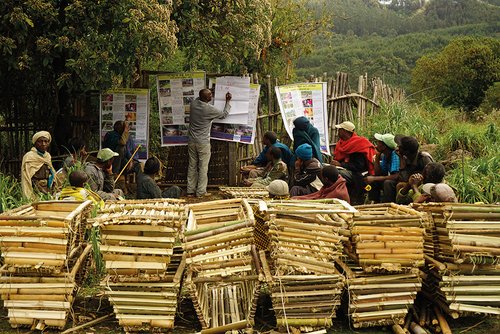
Trainings on modern apiculture, which provides an additional financial income for the villagers.
Moreover, a concentrated settlement of people in an urban village releases fertile land for food production as well as the regeneration of nature. Both the provision of infrastructure for the population and the management of cropland in a significantly more efficient, productive and sustainable manner are possible with the creation of urban-rural centres. Not only does infrastructure, i. e. mobility, roads, etc., improve the living conditions of the population, it also simplifies linking the rural centres to major markets. The people living in large cities depend on food supplies from rural regions, too.
So rural and urban development should to be integrated in order to create synergies for both. In addition, people can stay in their home regions, living together with their families and communities, and local traditions and culture can be preserved. A city offering an empowering environment with education, energy, Internet access and its own administration holds a big potential for entrepreneurship and value addition activities of local agricultural produce. A group of Ethiopian academics and people working in an honorary capacity have designed a concept for such a transformation of the country called “Grassroots Urbanisation”. It features an urbanisation as described above progressing sustainably and is based on empowerment and participation of the local population (bottom-up instead of top-down). A network of numerous small, sustainable urban settlements can emerge instead of constantly growing megacities in which the social and ecological problems grow equally.
From a national perspective, this means that there is not only a potential to lower migration and rural exodus, to improve living and working conditions in rural areas, to raise food security in both urban and rural areas and to promote economic development in rural regions. It can also contribute to national stability as well as security and peace.
Best practice of sustainable food system transformation
Situated at an altitude of around 3,000 m above sea-level, Metadel Asaye’s farm in the northern Ethiopian highlands, the Choke Mountains, shows how such a transformation can be implemented in practice. The Choke Mountains are a highly relevant and sensitive ecosystem which, with its more than 50 tributaries to the Blue Nile, makes a crucial contribution to the volume and quality of the Nile’s water and whose functionality thus has direct impacts reaching as far as Egypt.
Metadel is a pioneer and has always sought to achieve change and improvements in the life of the local farming community. For instance, in 2017, he convinced the community of the idea to give communal land to a small, sustainable initiative for agro-ecotourism, of which he has since been a leading (board) member. He applies what he has learnt in the Mulu Eco Village, an initiative founded in 2017 (see below), to his own farm, and his family have thus been working on a transformation of their farm since 2018. This has been possible although the family does not have more financial capital than other farmers in the region.
Through the growing network of the initiative and the farming community, more and more opportunities emerged for smaller and larger projects with various partners, such as NGOs, embassies, foreign and local associations or government institutions. For example, a cooperation scheme was formed with a photovoltaic company from the capital and access to governmental programmes run by local authorities on well construction or for biogas plants became easier. Thus, on the farm, step by step, an energy system was installed, as shown in the illustration. Irrigation with the solar water pump now also enables crop growing in dry season, which means that now three growing and harvesting cycles of potatoes and grain are possible each year and a vegetable garden as well as a greenhouse can be maintained.
The biogas plant turns animal and human faeces and accumulated bio-waste into biogas for cooking and biogas slurry, which is used as an organic fertiliser instead of chemical fertiliser and enhances soil health and fertility. The greenhouse enables the family to grow and consume a wide range of vegetable varieties, especially by storing the day’s heat throughout the cold nights. Thus, for instance, tomatoes, zucchini, eggplants, asparagus or tomatoes grow here – at an altitude of more than 3,000 metres!
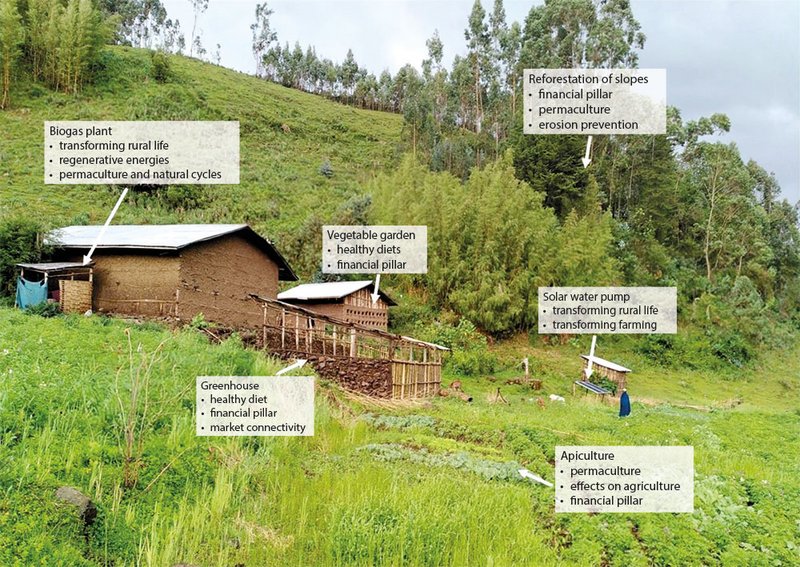
The illustration shows the transformed farm. It highlights all the areas which have seen new developments over the past years and the effects which these developments have had. Source: authors' presentation.
Now there is no longer any need to grow crops on mountain slopes. These are being reforested with bamboo which, just like apiculture, is a further financial pillar for the family. Bamboo is sold both on the local market and via middlemen to the cities and is used in sustainable building of furniture and houses. All those in the community who are interested in bee-keeping have received training on building better beehives via the Mulu Eco Village network. Thus knowledge of traditional apiculture can be combined with modern methods, and production can then be made even more efficient and sustainable. Thanks to bee pollination, in addition to honey production, keeping bees can contribute to high yields in agriculture, ecosystem conservation and diversified diets for families.
Photovoltaics and biogas enable simple access to electricity, water, sanitary installations and the Internet, and, through making information available, better market networking beyond the local weekly market in the village. Particularly the situation of the women and children on the farm has strongly improved through the transformation, since there is no need anymore to carry water or fire wood to the house. Cooking with biogas on smoke-free stoves reduces both the labour effort and the considerable health hazard, and in the evening, the biogas and photovoltaics offer enough light for doing the homework. Women and children can make use of the time resources thus gained for other activities. Since women are usually responsible for selling goods on the local markets, their financial situation is improving, too, by having more to offer in variety and amounts.
All in all, this enhances the quality of life in the region, which can contribute to reducing rural exodus. The best practice example is meant to demonstrate how many positive synergy effects can arise and what possibilities can emerge on the way if just a single individual opts for sustainable transformation, even though there are still many open questions at the beginning (regarding the right strategy, financing, etc.).
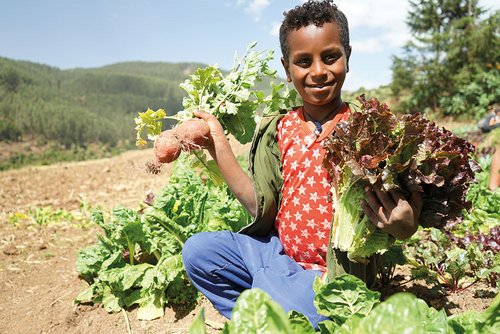
Farmer Metadel Asaye’s son harvesting vegetables.
A model for sustainable rural development: the Mulu Eco Village
The farm presented as best practice is part of the above-mentioned Mulu Eco Village, which was founded by two “urban returnees” together with the local farming community, consisting of 250 families, in 2017 and is organised as a cooperative. The Mulu Eco Lodge, a community ecotourism project which was distinguished as the “Best Tourism Village” by the United Nations in 2023, is also part of the Village. The farmers’ cooperative of the Mulu Eco Village is also developing and operating common infrastructure, such as a kindergarten and an education centre, a grinding mill and a health centre.
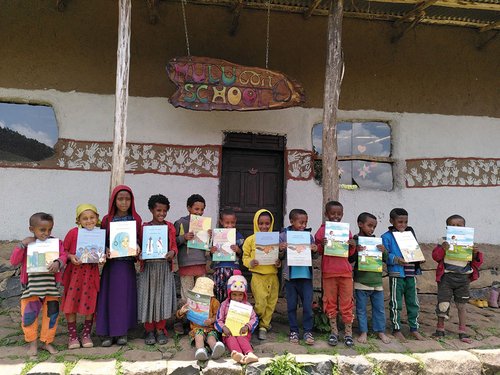
The farmers’ cooperative of the Mulu Eco Village also operates common infrastructure.
Over the next few years, the traditional farming systems of all families who are part of the cooperative will be transformed into sustainable production systems such as the best practice farm to ensure more food security, balanced diets and sustainable production systems. With the aid of external financial support, an urban village, as described above, is planned to be developed, in which the landless youth can process agricultural produce from the surrounding farms and create start-ups. In this manner, the region can be transformed into a model of sustainable rural development and provide inspiration for many other rural communities.
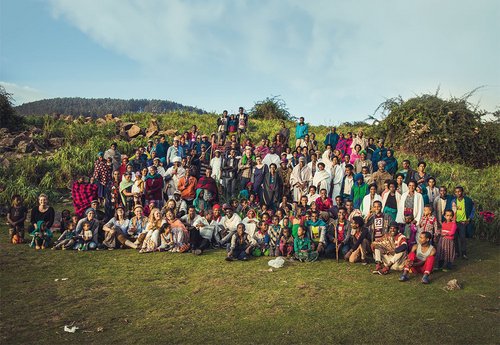
The Mulu Eco Village farmers' cooperative. Photos: Valerie Seitz
Valerie Seitz has been living and working in the Ethiopian highlands since 2014. She holds a Bachelor of Engineering in energy process engineering and is currently doing a Master’s course in sustainability management and technologies at Wilhelm Büchner University of Applied Sciences in Darmstadt, Germany. She is co-founder of Mulu Eco Village in the Choke Mountains, Ethiopia.
Birgit Zimmermann is a Professor at Wilhelm Büchner University of Applied Sciences and Director of Studies at the University’s Life Sciences Department. Since 2021, she has also been Vice-Dean of its Energy, Environment and Process Engineering Department.
Contact: valerie.seitz@extern.wb-fernstudium.de
Further reading (in German):
Seitz V. and Zimmermann B: “Nachhaltiges Energiekonzept für einen Bauernhaushalt im ländlichen Äthiopien”. In: Schriftenreihe der Wilhelm Büchner Hochschule, Band 7, Darmstadt, 2022, ISSN (Online): 2751-0514


